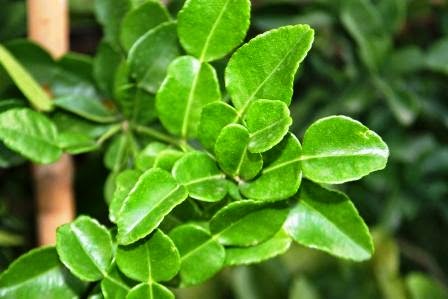Kafir Lime Leaf = Daun Jeruk Purut
Kafir Lime Leaf = Daun Jeruk Purut
The kaffir lime (Citrus hystrix), sometimes referred to in English as the makrut lime (see below) or Mauritius papeda,[2] is a fruit native to tropical Asia including India, Nepal, Bangladesh, Thailand, Indonesia, Malaysia and the Philippines. It is used in Southeast Asian cuisine and the oil from it is used in perfumery.[3]
English: makrut lime; French:[4] citron combera, combava, citron ridé; Burmese: tau shauk hka: (တောရှောက်ခါး; pronounced: [tɔ̀.ʃaʊʔ.kʰá]); Indonesian/Malay: jeruk obat, jeruk purut, limau purut; Filipino: kabuyao or cabuyao; Khmer: krô:ch saë:ch;[4] Laos: mak khi hut (ໝາກຂີ້ຫູດ; pronounced [ma᷆ːk.kʰi᷆ː.hu᷆ːt]); Thai: ma krut (มะกรูด; pronounced [ma.krùːt]);[5][6] also known as combava, kieffer lime, makrut lime, or magrood lime. In South Indian cuisine it is used widely and is known as "narthangai".
The Oxford Companion to Food (ISBN 0-19-211579-0) recommends that the name kaffir lime be avoided in favor of makrut lime because Kaffir is an offensive term in some cultures and has no good justification for being attached to this plant.
The rind of the makrut lime is commonly used in Lao and Thai curry paste, adding an aromatic, astringent flavor.[5] The zest of the fruit is used in creole cuisine to impart flavor in "arranged" rums in the Martinique, Réunion island and Madagascar. However, it is the hourglass-shaped leaves (comprising the leaf blade plus a flattened, leaf-like leaf-stalk or petiole) that are used most often in cooking. They can be used fresh or dried, and can be stored frozen. The leaves are widely used in Thai[5] and Lao cuisine (for dishes such as tom yum), and Cambodian cuisine (for the base paste "Krueng"). Makrut lime leaves are used in Vietnamese cuisine with chicken to add fragrance. They are also used when steaming snails to decrease the pungent odor while cooking. The leaves are also used in Indonesian cuisine (especially Balinese cuisine and Javanese cuisine), for foods such as Soto ayam, and are used along with Indonesian bay leaf for chicken and fish. They are also found in Malaysian and Burmese cuisines.[9] The juice is generally regarded as too acidic to use in food preparation. In Cambodia, the entire fruit is crystallized/candied for eating.[4]
The Kaffir lime tree (Citrus hystrix) is commonly grown for use in Asian cuisine. While this dwarf citrus tree, reaching up to 5 feet tall, can be grown outdoors (year round in USDA zones 9-10), it is best suited for indoors. The Kaffir lime tree thrives in potted environments and would benefit from placement out on the patio or deck; however, its container needs to provide adequate drainage.
Kaffir limes are about the size of Western limes. They are dark green with a bumpy surface. In order for the Kaffir lime tree to produce any limes, be sure to provide plenty of light for flowering.
Because they produce very little juice, the juice and flesh of Kaffir limes is rarely used, but the sour-tasting rind can be finely grated and used for flavoring dishes. Fresh Kaffir limes can be frozen using freezer bags and used as needed.
Kaffir limes have many household uses as well, including cleaning and hair conditioning.
Kaffir lime trees are generally not bothered by many pest problems but may become susceptible to mites or scale if left near infected plants.
Although it is possible to grow Kaffir lime trees from seed, this method is often difficult to achieve. Likewise, grafted trees tend to bloom and bear fruit earlier than seedlings.
Source
WIKIPEDIA






Comments
Post a Comment